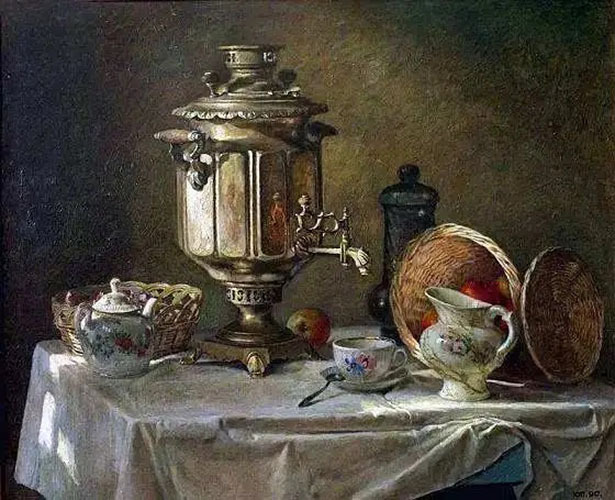Tea Culture

Russian Tea Culture
Russian Tea Culture
The Russian people have been drinking tea for centuries and it is one of the most common beverages in their diets,there are 82% of Russians drink it daily. The beverage has been around since 1638, when the first reference was made to "tea time" in Russia; an afternoon social gathering that involved sipping on this hot liquid while chatting about current events or just passing some pleasant sweets between friends.It was traditionally drunk at afternoon tea,but has since spread as an all day drink, especially at the end of meals served with dessert.The rich history behind this popular taste begins with its strong association with traditional Russian culture.
The four-legged vessel has become so iconic for this culture that you will find any inspired person holding on to their own little icon with fierce loyalty until death do they part - just like how we hold our loved ones close every day.The samovar is a symbol of hospitality and comfort in Russia. It was first created during the early 1770s, but became somewhat commonplace by 1890s because it brought them happiness when drinking their favorite beverage: tea!
The design of the samovar is an ingenious solution to one of history's most common challenges-boiling water. The samovar is a vessel that can be used to boil water and keep it warm. The center tube runs up through the middle, where charcoal or hot coals are placed on top in order for them both heat together while at base there's usually some form of crown-like covering with small metal pot known as chainik which holds strong concentrated tea called zavarka; this helps preserve your beverage by keeping its flavor locked inside!And today most samovars are electric. When it's time for a cup of Russian tea, the user pours some zavarka into an elaborate teacup or glass that sits in its own special fanciful filigree silver or enamel holder with handles (podstakannik). Hot boiled water comes out from spigots along side this fancy design of samovar and they're there to dilute your drink according to taste preference; ten parts kipyatok/1 partzavaika will do nicely most times but adjustments always have been made based on individual needs!
Muscovites are Russia's most noted tea drinkers. The first documented transaction involving the drink happened just over three centuries ago, when an ambassador brought Czar Alexei Mikhailovich 130 pounds from Mongolia in 1638 and offered him a hundred sableskins as gratitude for his kindness towards Russian traders during such harsh times.Russia's love for tea was first demonstrated in 1679 when they concluded a treaty with China on regular supplies of the beverage via camel caravan. The Chinese ambassador to Moscow gifted several chests of tea to Alexis I, but because it took so long and cost quite an arm financially, only royalty and the wealthy could enjoy these luxurious goods.In 1689, a treaty was signed that formalized Russia's sovereignty over Siberia and created the Tea Road which traders used to transport goods between China and Europe.
Between the Treaty of Nerchinsk and the Treaty of Kiakhta(1972),Russia would increase its caravans going to China for tea, but only through state dealers. In 1706, Peter the Great made it illegal for any merchants to trade in Beijing. But by 1736 Catherine II had established regular imports of tea and her subjects could finally afford a cup or two with their meals! By this time Russia was importing more than 3 million pounds per camel caravan at its height--enough that lower classes would be able drinking less expensively.
The late 19th century was a pivotal time for Russia's relationship with tea. Though not available or affordable to most people until then, by the end of that decade it had become an integral part in social life and culture as vodka among many Russian citizens - even today you'll find them drinking their favorite aromatic black brew at all hours across town in Russia!The peak year for the Kiakhta tea trade was in 1824, and the peak year for the tea caravans was 1860. By then, the first leg of Russia’s Trans-Siberian Railway had been completed in 1880. This allowed for tea to be imported from nearly 1 year and a half to just around a week.The decline of Chinese tea in the mid 19th century meant that Russia began to import more from Odessa and London.By 1905, horse drawn tea transport had ended and by 1925 caravan were only means to get your fix.
The ritual of tea-drinking in Russia has its roots deeply rooted into history and culture. Aleksander Pushkin(1799-1837 AD), the great Russian writer who chronicled this practice for generations to come with his poetry full of rich descriptions about chaepitie (tea drinking) among upper classes became an integral part during 19th century society's everyday habits while also establishing it nationally conscious institutionally.
Tea in Russia was not considered self-dependent; thus, even the prosperous classes adorned it with jams and syrups and other sweets. Within Russian culture there are many different ways to prepare one’s favorite beverage.Russian tea preparation is as unique and diverse in Russia itself.The most common form of hot strong brewing includes lemon, sugar or jam,cakes,cookies,candies etc with boiling water to pour over it after you've enjoyed your cup for a while! Russian teapots also come equipped like an urn called a samovar ; Lomonosov tea set consisting mostly out porcelain cups ;and tea glass holders specifically designed.
*** Visit our website to learn more about the best quality Chinese teas at admiringazeland.com.
0users like this.




